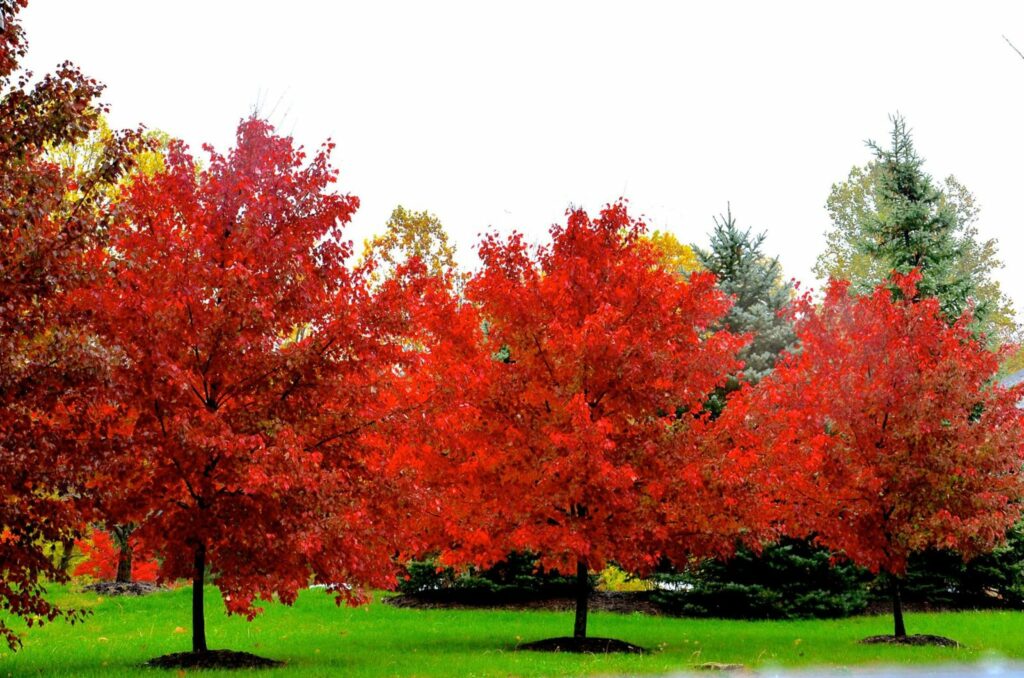Fall is the perfect season for planting trees, but before you grab that tree with stunning autumn
colors at the nursery, take a moment to research. Some trees may look beautiful, but their
vibrant colors can hide potential problems, like poor adaptation to your climate, general health
issues, or short lifespans due to breeding flaws that emerge years after planting.
One tree to avoid is the Silver Maple. Often planted by builders in new developments because
they grow quickly, these trees are not worth the trouble. By the time you realize the tree is
struggling, you’ll have lost years that could have been spent growing a healthier, longer-lasting
tree. If you find one in your yard, it’s better to remove it and invest in a higher-quality species.
For Central Indiana, selecting trees that offer both beauty and resilience to the local climate is
important. Here are some of the best options for landscape and aesthetics:
- Sugar Maple (Acer saccharum)
•Why it’s great: Known for its stunning fall color, with leaves turning bright shades
of orange, red, and yellow. It’s a hardy tree that adapts well to Indiana’s climate.
•Height: 60-75 feet
•Spread: 40-50 feet - Redbud (Cercis canadensis)
•Why it’s great: A small, ornamental tree with beautiful pink or purple flowers in
early spring. It’s a native species that thrives in Indiana and adds early-season color to your
landscape.
•Height: 20-30 feet
•Spread: 25-35 feet - White Oak (Quercus alba)
•Why it’s great: A majestic tree with deep green leaves that turn crimson and
purple in fall. It’s long-lived, drought-tolerant, and provides great shade.
•Height: 50-80 feet
•Spread: 50-80 feet - Serviceberry (Amelanchier canadensis)
•Why it’s great: A multi-season beauty, it offers white spring blossoms, edible
berries in summer, and stunning orange-red fall foliage. It’s also a good tree for wildlife
attraction.
•Height: 15-25 feet
•Spread: 15-25 feet - Tulip Tree (Liriodendron tulipifera)
•Why it’s great: Indiana’s state tree, it grows tall with beautiful tulip-shaped
flowers in spring and bright yellow leaves in the fall.
•Height: 70-90 feet
•Spread: 35-50 feet - Dogwood (Cornus florida)
•Why it’s great: Popular for its beautiful white or pink spring flowers and bright
red berries in fall. It works well in small yards or as an accent tree.
•Height: 15-30 feet
•Spread: 25-35 feet - American Beech (Fagus grandifolia)
•Why it’s great: Known for its smooth, silvery bark and rich yellow-gold fall color.
It’s slow-growing but provides a stately presence in the landscape.
•Height: 50-70 feet
•Spread: 40-60 feet - Eastern Red Cedar (Juniperus virginiana)
•Why it’s great: A tough, evergreen tree that adds year-round greenery. It’s
drought-tolerant and can handle Indiana’s cold winters.
•Height: 30-50 feet
•Spread: 8-20 feet - Hackberry (Celtis occidentalis)
•Why it’s great: Extremely hardy, adaptable to various soils, and drought resistant. The tree provides great shade and interesting bark texture.
•Height: 40-60 feet
•Spread: 40-50 feet - Flowering Crabapple (Malus spp.)
•Why it’s great: Offers vibrant spring flowers in shades of pink, red, or white, and
small decorative fruit in the fall. It’s a perfect choice for color and visual interest.
•Height: 15-25 feet
•Spread: 15-25 feet
These trees not only enhance the beauty of your landscape but are also well-suited to Central
Indiana’s climate, providing lasting beauty throughout the seasons.


